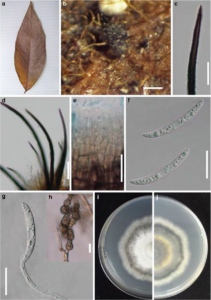Colletotrichum fusiforme Jayaward., Bhat, Tangthir. & K.D. Hyde, in Ariyawansa et al., Fungal Diversity: 10.1007/s13225-015-0346-5, [132] (2015)
Index Fungorum number: IF551299; Facesoffungi number: FoF00851
Etymology – Based on the fusiform conidia.
Holotype – MFLU 13-0291
Saprobic on leaves. Sexual morph: Undetermined. Asexual morph: Conidiomata 70–140 μm (x = 80 μm, n=10) diam., solitary, an acervulus, black, globose- oval with pale yellow spore mass. Setae abundant, 95–225 μm long, dark brown to medium brown, smooth-walled, curved, 1–4-septate, base cylindrical, conical with slightlyinflated, 3–5 μm diam., apex acute. Conidiophores septate, to 31 μm long, hyaline to pale brown, smooth–walled densely clustered. Conidiogenous cells 6–9×1–2 μm (x = 7×2 μm, n=20), reduced hyaline, smooth–walled, cylindrical, collarette rarely observed, periclinal thickening not observed. Conidia 34– 44×3–5 μm (x = 35×4 μm, n=40), hyaline, fusiform, aseptate, curved, base rounded and truncate with a slightly acute apex, guttulate, smooth-walled or verruculose, L/W ratio=8.2. Appressoria 6–11×3–4 μm (x = 10×3 μm, n=10) solitary to aggregated, in short chains, oval, medium to dark brown, smooth-walled.
Cultural characteristics: Colonies on PDA reaching 55 mm in 7 days at 28 °C, margin undulate, white aerial mycelium becoming olivaceous green to dull green olivaceous green towards the edge from forward, reverse olivaceous green to dull green, concentric.
Material examined – THAILAND, Chiang Rai, on a dead leaf, host unknown, 14 July 2012, J. Bhat NTCL98, (MFLU 13-0291, holotype); ex-type living cultures, MFLUCC 12– 0437, KUMCC, CFTCC.
Notes – Colletotrichum fusiforme clusters in the truncatum species complex (Fig. 1), forming a separate branch with 86 % bootstrap support and 0.96 Bayesian posterior probability. This species differs from its sister taxon C. truncatum (Schwein.) Andrus & W.D. Moore by having dark brown to medium brown setae, while the setae of C. truncatum are hyaline to pale brown. The L/W ratio of C. fusiforme conidia is larger (8.2) than that of C. truncatum (5.7). Conidia of C. fusiforme are curved, with a rounded and truncate base and slightly acute apex, while in C. truncatum conidia are strongly curved at the apex (Damm et al. 2009).

Fig. 1 Colletotrichum fusiforme (holotype) a Herbarium specimen b Black acervuli c Acute apex of the setae d Setae with conidiophores e Conidiophores f Hyaline conidia g Germinating conidiumh Appressoria i Upper view of the colony j Lower view of the colony. Scale bars: b= 100 μm, c, d=20 μm, e–g=15 μm, h=10 μm
